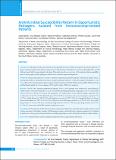Please use this identifier to cite or link to this item:
https://hdl.handle.net/20.500.14356/965Full metadata record
| DC Field | Value | Language |
|---|---|---|
| dc.contributor.author | Basnet, Ajaya | - |
| dc.contributor.author | Chand, Arun Bahadur | - |
| dc.contributor.author | Pokhrel, Nayanum | - |
| dc.contributor.author | Acharya, Sadikchya | - |
| dc.contributor.author | Gurung, Parbati | - |
| dc.contributor.author | Khanal, Laxmi Kant | - |
| dc.contributor.author | Shrestha, Kundu | - |
| dc.contributor.author | Shrestha, Lok Bahadur | - |
| dc.contributor.author | Raghubanshi, Bijendra Raj | - |
| dc.date.accessioned | 2023-04-18T06:29:08Z | - |
| dc.date.available | 2023-04-18T06:29:08Z | - |
| dc.date.issued | 2022 | - |
| dc.identifier.citation | BasnetA., ChandA. B., PokhrelN., AcharyaS., GurungP., KhanalL. K., ShresthaK., ShresthaL. B., & RaghubanshiB. R. (2023). Antimicrobial Susceptibility Pattern in Opportunistic Pathogens Isolated from Immunocompromised Patients. Journal of Nepal Health Research Council, 20(3), 664-671. https://doi.org/10.33314/jnhrc.v20i3.4047 | en_US |
| dc.identifier.issn | Print ISSN: 1727-5482; Online ISSN: 1999-6217 | - |
| dc.identifier.uri | http://103.69.126.140:8080/handle/20.500.14356/965 | - |
| dc.description | Original Article | en_US |
| dc.description.abstract | Abstract Background: Brought with the advancements in transplantation science and the development of immunosuppressive agents, immunocompromised patients characterized with defective immunity have increased throughout the world with increased risk for opportunistic infections. This study provides an overview of the antimicrobial susceptibility pattern among opportunistic pathogens isolated from immunocompromised patients. Methods: Clinical and laboratory records of immunocompromised patients [patients with chronic kidney disease neutropenia, diabetes, rheumatic heart disease acquired immune deficiency syndrome hepatitis B, hepatitis C, who were subjected to microbiological culture analysis in the Department of Clinical Microbiology, KIST Medical College and Teaching Hospital, for 2 years (January 2019 and December 2020) were analyzed. Results: Out of 8,402 immunocompromised patients, 954 (11.4%) patients were subjected to microbiological culture analysis. Among 954 patients, 253 (26.5%) patients [median(interquartile range) age: 52(31-67) years; male 138 (54.5%)] were infected. A total of 295 pathogens were isolated from 1,331 cultured samples. Infections due to Escherichia coli (n=71, 24.1%), Klebsiella spp. (n=55, 18.6%), Acinetobacter calcoaceticus-baumannii complex (n=35, 11.9%), Candida albicans (n=30, 10.2%), and Staphylococcus aureus (n=28, 9.5%) were frequently observed. Among the bacterial isolates (n=239), 81.6% (n=195) of bacteria were β-lactamase producers, 51.0% (n=122) were multi-drug resistant, 9.2% (n=195) were extensively-drug resistant, 0.8% (n=195) were pan-drug resistant, and 35.7% (n=10) of S. aureus were methicillin-resistant Staphylococcus aureus. Conclusions: The majority of infection in immunocompromised patients is caused by Gram-negative bacteria, and is often associated with a higher number of β-lactamase producers and multi-drug resistant organisms. Prescriptions of antibiotics on the grounds of antimicrobial stewardship might help to reduce the burden of antimicrobial resistance. Keywords: Antimicrobial resistance; immunocompromised host; opportunistic infections. | en_US |
| dc.language.iso | en | en_US |
| dc.publisher | Nepal Health Research Council | en_US |
| dc.relation.ispartofseries | July-Sep, 2022;4047 | - |
| dc.subject | Antimicrobial resistance | en_US |
| dc.subject | Immunocompromised host | en_US |
| dc.subject | Opportunistic infections | en_US |
| dc.title | Antimicrobial Susceptibility Pattern in Opportunistic Pathogens Isolated from Immunocompromised Patients | en_US |
| dc.type | Journal Article | en_US |
| Appears in Collections: | Vol 20 No 3 Issue 56 july-Sep, 2022 | |
Files in This Item:
| File | Description | Size | Format | |
|---|---|---|---|---|
| 4047-Manuscript-30773-1-10-20230314.pdf | Fulltext Downlaod. | 345.7 kB | Adobe PDF |  View/Open |
Items in DSpace are protected by copyright, with all rights reserved, unless otherwise indicated.
